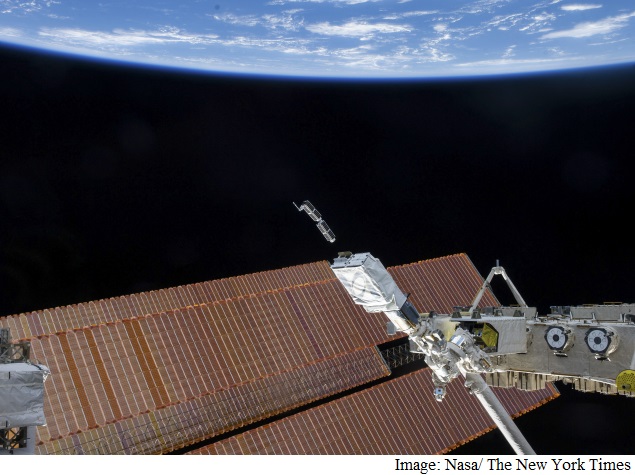- Home
- Internet
- Internet Features
- Internet in Orbit
Internet in Orbit

Building on that, Google and the mutual fund giant Fidelity announced a $1 billion (roughly Rs. 6,153 crores) investment Tuesday into Space Exploration Technologies, a growing private rocket company that is still trying to prove itself on the world stage. The company, also known as SpaceX, could give Google a way to put its devices into outer space.
With that growing collection of devices in the sky, Google believes it can spread the Internet to underserved areas around the world. The investments also reflect a bit of enlightened self-interest, since the more people who are connected directly to Google, the more ads it can show them. And that is how Google makes its money.
"Anything they provide, if it's going through their own pipe, they have more control over the experience and more potential for revenue," said J.P. Gownder, an analyst at Forrester Research. That means those consumers are more likely to stick with Google services like search, Gmail or YouTube rather than going somewhere else.
Google's interest in satellites is anything but original. Last week, the Virgin Group and Qualcomm, a maker of communications semiconductors, announced they had invested in OneWeb, a network of Internet connectivity satellites, while Planet Labs, a maker of shoebox-size satellites that offer Earth imagery, announced Tuesday it had received $95 million (roughly Rs. 584 crores) in financing.
Last year, Facebook bought a British drone maker and hired a bevy of top aerospace scientists, with the goal of deploying high-altitude, unmanned planes to deliver Internet service to parts of the world that have little connectivity now. The company is also experimenting with satellites and lasers to deliver Internet services.
These companies have different technologies and different ideas for making money, but the bind among them is a common assumption that there is no economic way to physically wire the world's underserved consumers. So the only way to do it is with satellites and other wireless technologies.
There is another benefit for Google: The company is always looking for ways to get around Internet service providers. As Google executives have shown with new offerings, from insurance shopping to the growing Google Fiber broadband service, if there is one thing they believe, it is that their company's interests are best served by going directly to the consumer.
And as first reported on the tech website The Information, Google has been in talks with cellular network companies with a goal of providing its own wireless service, according to two people familiar with Google's efforts.
"If you're a big Internet company, you don't want to have to deal with every cable company, every telco, that are potentially or actually trying to interfere with your freedom to do business," said Steve Jurvetson, a founder and partner at Draper Fisher Jurvetson, a Menlo Park, California, venture capital firm. He is on the boards of both SpaceX and Planet Labs.
This idea of sky-high Internet connections seems to be a fixture of technology booms. In the mid-1990s, there were similar efforts. One, called Sky Station, was a sort of stratospheric blimp that would hover over areas that needed broadband Internet service. It was not successful, mostly because there was not much demand for the high-speed access it could provide, said Martine Rothblatt, the inventor of the satellite service SiriusXM who was a partner in Sky Station and is now the chief executive of United Therapeutics, a biotechnology company.
"Twenty years ago, when people were like really happy to get a phone call on a mobile phone, it was inconceivable that most people's television platform would be their mobile" device, Rothblatt said.
Today, Rothblatt added, the demand for bandwidth is "essentially insatiable."
The interest in satellites also extends to services. Last year, Google spent about $500 million to buy Skybox Imaging, a maker of small high-resolution imaging satellites that could do things like monitor crops or map the terrain below a forest canopy.
But be it imaging or connections, the recent interest in satellites stems from a reduction in satellite cost. Unlike the first space race, when governments had to make almost everything themselves, there are now all kinds of off-the-shelf chips, batteries and other components that can be mixed and matched. And just as the camera on your mobile phone becomes better with each upgrade, the advancement in space imaging technology has been rapid.
"Aerospace is following business because the dominant research and development dollars are no longer in the Air Force or Nasa, but they are in Google and Apple and all these places pushing the boundaries of miniaturized electronics," said Will Marshall, co-founder and chief executive of Planet Labs.
There is nothing new about connecting to the Internet via satellite. People do it on airplanes, at sea and in remote corners of the world. ViaSat, a Carlsbad, California, satellite company, beams satellite Internet to 700,000 homes and apartments in the United States. But this is done with bigger, higher-orbiting satellites that sit in a geosynchronous orbit, meaning they move at the same speed as the earth and so stay above a fixed point.
Mark Dankberg, ViaSat chief executive, estimated that dozens of companies around the world are working on satellite-based Internet services that are regional in scope and use these higher-orbit technologies.
But the satellites Internet companies have become enamored of use lower orbits and can cover the world to put the 3 billion people who do not have Internet access online.
Low-Earth-orbit satellites are already revolutionizing imaging technologies by allowing companies to receive continuously updated pictures of earth, which lets them do things like measure a mall's hourly parking lot traffic. But whether these satellites can be used to connect people to the Internet more cheaply has yet to be proved, Dankberg said.
One advantage is that low-Earth satellites could have less lag between typing a search into Google and receiving the results.
But since most of the world is water and barren land, Dankberg said, a fleet of Internet-connected satellites would have many of its components hovering over unpopulated areas.
"It has yet to be proven that lots of little satellites can provide Internet more cheaply than a handful of big ones," he said.
© 2015 New York Times News Service
Catch the latest from the Consumer Electronics Show on Gadgets 360, at our CES 2026 hub.
Related Stories
- Samsung Galaxy Unpacked 2025
- ChatGPT
- Redmi Note 14 Pro+
- iPhone 16
- Apple Vision Pro
- Oneplus 12
- OnePlus Nord CE 3 Lite 5G
- iPhone 13
- Xiaomi 14 Pro
- Oppo Find N3
- Tecno Spark Go (2023)
- Realme V30
- Best Phones Under 25000
- Samsung Galaxy S24 Series
- Cryptocurrency
- iQoo 12
- Samsung Galaxy S24 Ultra
- Giottus
- Samsung Galaxy Z Flip 5
- Apple 'Scary Fast'
- Housefull 5
- GoPro Hero 12 Black Review
- Invincible Season 2
- JioGlass
- HD Ready TV
- Laptop Under 50000
- Smartwatch Under 10000
- Latest Mobile Phones
- Compare Phones
- Honor Win RT
- Honor Win
- Xiaomi 17 Ultra Leica Edition
- Xiaomi 17 Ultra
- Huawei Nova 15
- Huawei Nova 15 Pro
- Huawei Nova 15 Ultra
- OnePlus 15R
- Asus ProArt P16
- MacBook Pro 14-inch (M5, 2025)
- OPPO Pad Air 5
- Huawei MatePad 11.5 (2026)
- Xiaomi Watch 5
- Huawei Watch 10th Anniversary Edition
- Acerpure Nitro Z Series 100-inch QLED TV
- Samsung 43 Inch LED Ultra HD (4K) Smart TV (UA43UE81AFULXL)
- Asus ROG Ally
- Nintendo Switch Lite
- Haier 1.6 Ton 5 Star Inverter Split AC (HSU19G-MZAID5BN-INV)
- Haier 1.6 Ton 5 Star Inverter Split AC (HSU19G-MZAIM5BN-INV)
















